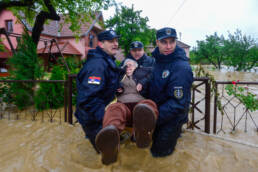
That night in May, when the rain started to fall, no one could even guess how much chaos, drama and unfathomable consequences will remain imprinted in the soil, caused by the impact of each of countless drops. History will record that it was not just the ordinary spring shower, but one of the largest, rainiest and most devastating cyclones that have affected this area since the data is being collected and written.
Meteorologists will, a few hours after this beast has already loomed menacingly over the lands of the former Yugoslavia and began to release its hevy load, give it the name Tamara – so lovely and difficult to connect with such a devastating phenomenon.
A cyclone of this intensity and size is not typical for our climate. Satellite images showed a dramatic progression of a huge cloud with it’s center moved deeply into the mainland – somewhere above Serbia. It kept spinning for days on its own, soaking the land already saturated with water. Rivers, swollen from the spring rains and melting snow, could not accommodate in their own troughs a huge amount of new water that came from all sides. Barely visible harmless streams turned in a moment into destructive torrents that carried everything before them. Sava river left its bed, followed by most of the rivers within its basin. Disaster was on the horizon.
Our profession puts us in the front rows of the drama, side by side with everyone who had or wanted to be there, trying to help and save human lives. There are things that we will never forget. Shouting and screams of people from the rooftops of submerged houses, the power of the torrent that carries before our eyes cars and bridges, huge efforts of rescue teams to resist the force of water, and bound to each other, reach those who need help, palpable sadness in the eyes of those who have just arrived to the collective centers, as well as hugs of relief and tears of joy over reunion, and children who sleep carefree in the unknown environment… For sure, it is something that will remain documented for eternity, but even more strongly and more convincingly imprinted in our minds.
Whilst these lines were written, the sound of thunder was getting louder outside, heralding a new storm. Common sense supported by the statistics was saying that a short-term effect will not bring a new danger of this magnitude. Still, rumbling sound that symbolizes the strength and indomitability of nature calls for caution, and does not allow the tragic experience that we all went through in the recent past to be easily forgotten. We want to believe our documents of these tragic events will have a similar function in the future.